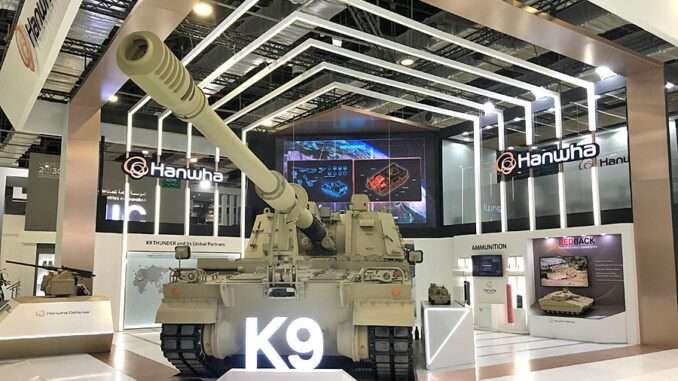
Rani Ziadeh
In the ever-evolving landscape of modern warfare, the role of self-propelled artillery systems remains pivotal. As conflicts grow increasingly dynamic and demand rapid mobility, precision strike capability, and integration with advanced command networks, nations around the world continue to invest heavily in next-generation howitzers. These platforms not only deliver overwhelming firepower but also offer strategic flexibility across diverse combat environments — from conventional battlefields to asymmetric engagements.
This comprehensive report examines ten of the most advanced self-propelled artillery systems globally, showcasing innovations from Europe, Asia, the Americas, and beyond. From the formidable German PzH 2000 and South Korea’s versatile K9A2 Thunder, to Sweden’s highly mobile Archer FH77BW and France’s agile CAESAR Mk II, each system represents the cutting edge of firepower, automation, and survivability. We also explore American long-range precision developments with the M1299 ERCA, China’s PLZ-05, Russia’s formidable 2S35 Koalitsiya-SV, Poland’s AHS Krab, and South Africa’s rugged G6-52 Rhino.
Through detailed analysis of design philosophies, operational performance, and technological advancements, this report offers defense professionals, military strategists, and defense industry stakeholders a comprehensive understanding of how these artillery systems are reshaping contemporary combat power and influencing the future battlefield.
Top 9 Most Advanced Self-Propelled Artillery Systems in the World (2025)
- PzH 2000 (Panzerhaubitze 2000) – Germany
- K9A2 Thunder – South Korea
- Archer FH77BW – Sweden
- CAESAR Mk II – France
- M1299 ERCA – United States
- PLZ-05 – China
- 2S35 Koalitsiya-SV – Russia
- AHS Krab – Poland
- G6-52 Rhino – South Africa
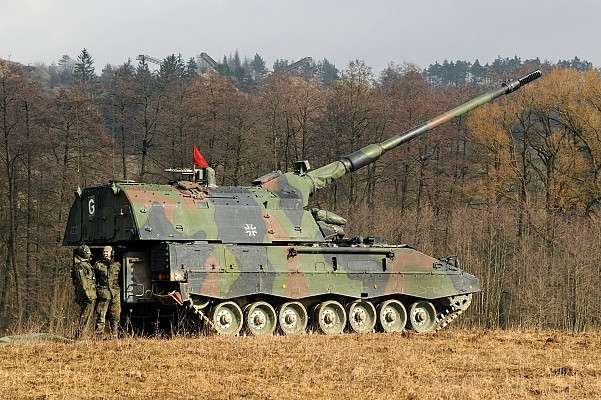
1. PzH 2000 (Panzerhaubitze 2000) – Germany
Introduction & Development History
Developed by Krauss-Maffei Wegmann (KMW) and Rheinmetall, the PzH 2000 entered service in 1998. Designed post-Cold War to give the Bundeswehr and NATO allies superior rapid-fire artillery with high automation and precision. It remains the gold standard globally.
Key Specifications
- Caliber: 155mm / L52
- Rate of Fire: 10 rounds per minute (burst mode)
- Max Range: 30 km (standard), 40–67 km (assisted/exotic munitions)
- Ammunition Types: HE, smoke, illumination, BONUS, SMArt 155, VLAP
- Mobility: MTU MT881 Ka-500 1,000 hp; 60 km/h; operational range 420 km
- Crew Size: 5 (typically 3 in automated mode, 5 for manual backup)
- Weight: 55–60 tons (varies by armor package)
- Armor Protection: STANAG Level 4; mine-resistant floor; NBC protection
- Unique Features: Fully automated loading, climate control, modular armor
Fire Control & Targeting Systems
- Advanced integrated fire control computer
- Sighting systems with GPS and inertial navigation
- Automated laying system and data-link connectivity for networked warfare
Operational Use & Combat History
- Used by Germany, Netherlands, Italy, Croatia, and Ukraine
- Proven effectiveness in Afghanistan and the Ukraine conflict, praised for accuracy and rate of fire
Strengths & Weaknesses
Strengths: Rapid fire, precision, automation, excellent protection
Weaknesses: Heavy weight limits strategic mobility
Variants
- PzH 2000 A1: Enhanced protection and communications suite
- Export versions with customized fire control
2. K9A2 Thunder – South Korea
Introduction & Development History
Developed by Hanwha Defense, K9 Thunder first entered service in 1999, with the A2 upgrade introducing automation and improved combat systems in early 2020s to maintain edge against North Korean artillery threat.
Key Specifications
- Caliber: 155mm / L52
- Rate of Fire: 6–8 rpm sustained; 3-round burst in 15 seconds
- Max Range: 30–40 km (standard), 50 km (RAP)
- Ammunition Types: HE, smoke, precision-guided munitions
- Mobility: 1,000 hp MTU MT881 Ka-500 diesel; 67 km/h; 480 km range
- Crew Size: 3–5 (A2 automated for 3)
- Weight: ~47 tons
- Armor Protection: STANAG Level 2–3 (front arc vs. 14.5mm AP; sides resist 7.62mm)
- Unique Features: Auto-loading, fully digitized systems
Fire Control & Targeting Systems
- Samsung Thales fire control suite
- GPS/INS, digital mapping, ballistic computation
- Integrated Command & Control systems
Operational Use & Combat History
- Operated by South Korea, Poland, India, Australia, Egypt, Norway, Finland, Estonia
- Massive export success; deployed in Korea for counter-battery roles
Strengths & Weaknesses
Strengths: High reliability, automation, export versatility
Weaknesses: Protection not as high as heavier peers
Variants
- K9A2: Automation and performance upgrades
- K9A3: Autonomous operation and extended range
3. Archer FH77BW – Sweden
Introduction & Development History
BAE Systems Bofors developed Archer to meet Swedish Army requirements for high-mobility precision artillery suited for Nordic terrain, first delivered in 2013.
Key Specifications
- Caliber: 155mm / L52
- Rate of Fire: 6 rpm
- Max Range: 30 km (standard), 60+ km (precision-guided)
- Ammunition Types: HE, Excalibur, BONUS, smoke, illumination
- Mobility: Volvo 6×6 truck chassis, 90 km/h, 500 km range
- Crew Size: 3–4 (high automation)
- Weight: ~30 tons
- Armor Protection: Cabin armor, mine-resistant
- Unique Features: Shoot-and-scoot in under 30 seconds, high automation
Fire Control & Targeting Systems
- Fully automated aiming and loading system
- INS/GPS navigation, digital fire control
- M982 Excalibur compatibility for precision strikes
Operational Use & Combat History
- Operated by Sweden, Norway, and selected units in Ukraine
- Combat-proven effectiveness in cold and urban terrains
Strengths & Weaknesses
Strengths: Rapid deployment, precision, lightweight for air transport
Weaknesses: Less armor protection
Variants
- Archer Mk II: Improved automation and C4ISR integration
4. CAESAR Mk II – France
Introduction & Development History
Nexter developed CAESAR (CAmion Équipé d’un Système d’ARtillerie) as a lightweight, truck-mounted artillery system, with the Mk II debuting in 2021 featuring improved protection and automation.
Key Specifications
- Caliber: 155mm / L52
- Rate of Fire: 6–8 rpm
- Max Range: 40–42 km (base bleed), 50+ km (rocket-assisted)
- Ammunition Types: HE, smart munitions, illumination, smoke
- Mobility: Renault Sherpa 6×6 or Arquus 8×8; 90 km/h; 600 km range
- Crew Size: 3–5
- Weight: ~18 tons (6×6 version), ~30 tons (8×8 version)
- Armor Protection: Cabin armored against small arms and shrapnel
- Unique Features: Air transportable by A400M/C-130, shoot-and-scoot
Fire Control & Targeting Systems
- SIGMA 30 navigation and fire control
- Excalibur-capable
Operational Use & Combat History
- Used by France, Indonesia, Saudi Arabia, Ukraine
- Extensively used in Mali, Ukraine, Iraq with strong battlefield reputation
Strengths & Weaknesses
Strengths: Highly mobile, fast deployment, cost-effective
Weaknesses: Less armor protection
Variants
- CAESAR 8×8: Higher ammunition capacity and stability
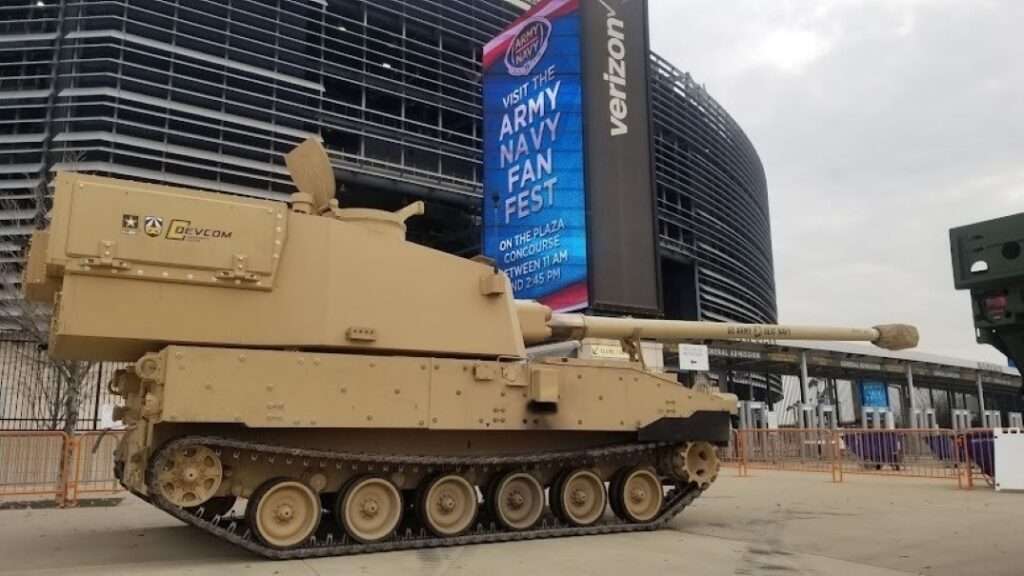
5. M1299 ERCA – United States
Introduction & Development History
Developed under the Extended Range Cannon Artillery (ERCA) program by the U.S. Army to counter peer threats, leveraging the M109A7 platform with extended barrel and advanced munitions.
Key Specifications
- Caliber: 155mm / L58
- Rate of Fire: 4 rpm sustained
- Max Range: 40–70 km (XM1113 RAP), 100+ km (HVP & RAAM future rounds)
- Ammunition Types: XM1113 RAP, precision-guided, conventional
- Mobility: Bradley-derived chassis, ~64 km/h, 350 km range
- Crew Size: 4
- Weight: 40 tons
- Armor Protection: Improved M109A7 level, STANAG Level 2+
- Unique Features: Autoloader under development, extended barrel
Fire Control & Targeting Systems
- Advanced fire control system
- Precision guidance and networking for multi-domain ops
- C2 integration with future battlefield networks
Operational Use & Combat History
- Used in Ukraine conflict.
Strengths & Weaknesses
Strengths: Future-proofed range and networking
Weaknesses: Development risks and weight
Variants
- Autoloader-equipped versions under test
6. PLZ-05 – China
Introduction & Development History
The PLZ-05 is China’s premier 155mm self-propelled howitzer, developed by NORINCO. Entered service in 2008, based on lessons from the PLZ-45 and designed to match NATO standards and outrange regional adversaries.
Key Specifications
- Caliber: 155mm / L52
- Rate of Fire: 8–10 rpm (burst), 5–6 rpm sustained
- Max Range: 30 km (standard), 40–53 km (RAP/precision-guided)
- Ammunition Types: HE, cargo rounds, laser-guided, GPS-guided (GP6), cluster munitions
- Mobility: 800 hp diesel engine, 55 km/h, range ~500 km
- Crew Size: 4–5
- Weight: ~35 tons
- Armor Protection: Light armor against small arms and shrapnel; NBC protection
- Unique Features: Chinese precision-guided artillery shells, automated fire control
Fire Control & Targeting Systems
- Digital fire control with integrated GPS/INS
- Data-linked targeting with UAVs and artillery radar
- Full network integration with Chinese C4ISR systems
Operational Use & Combat History
- PLA service; no known combat usage but numerous large-scale exercises and regional deployments (Taiwan Strait, Indian border)
Strengths & Weaknesses
Strengths: Long-range precision munitions, fast deployment, digital integration
Weaknesses: Protection level lower than Western peers
Variants
- PLZ-05A: Improved electronics and range capabilities
- Export models: PLZ-45 and AR1A systems
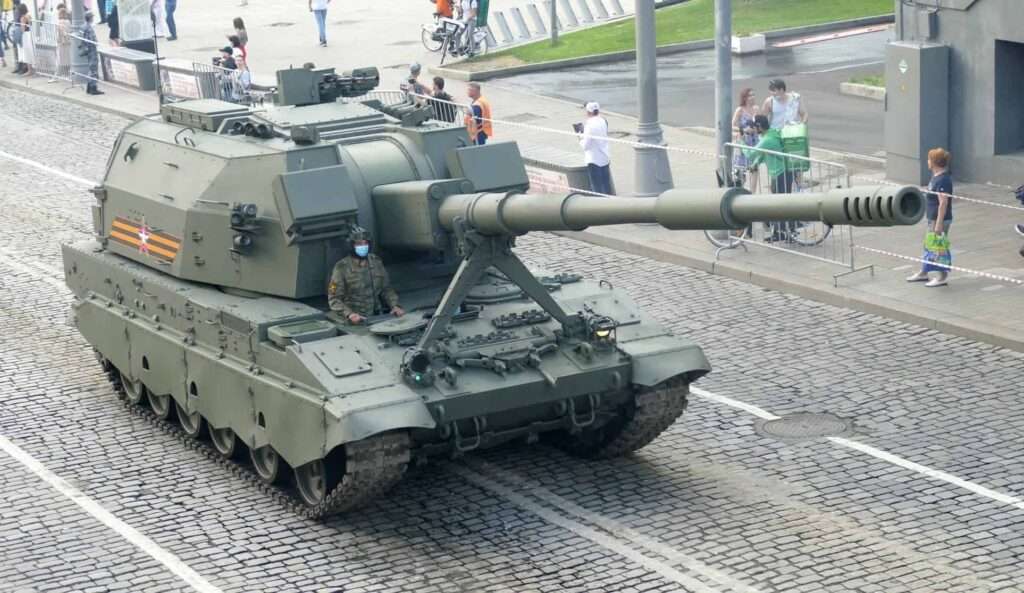
7. 2S35 Koalitsiya-SV – Russia
Introduction & Development History
Russia’s latest self-propelled howitzer, intended to replace the venerable 2S19 Msta-S. Development accelerated post-2010, focusing on surpassing NATO artillery capabilities in range and rate of fire.
Key Specifications
- Caliber: 152mm (Russian standard)
- Rate of Fire: Up to 16–20 rpm (advanced autoloader)
- Max Range: 40–70 km (RAP and precision rounds)
- Ammunition Types: HE, cargo, precision-guided Krasnopol, thermobaric
- Mobility: T-90 tank chassis, 1,000 hp engine, 60 km/h, ~500 km range
- Crew Size: 3 (high automation)
- Weight: ~55 tons
- Armor Protection: Armored turret, NBC protection
- Unique Features: Dual-feed autoloader, remote-controlled turret, “one-man crew” capability under emergencies
Fire Control & Targeting Systems
- Fully automated fire control
- GLONASS/GPS guidance, data-link networking
- Radar-guided trajectory correction and UAV targeting support
Operational Use & Combat History
- Entering Russian service progressively from 2021 onwards
- Exercises in Belarus and Western Military District indicate combat readiness
Strengths & Weaknesses
Strengths: High automation, rate of fire, long range
Weaknesses: Heavy weight, complex logistics
Variants
- Base Koalitsiya-SV
- Koalitsiya-SV-KSh (command vehicle)
- Planned wheeled variant for rapid deployment
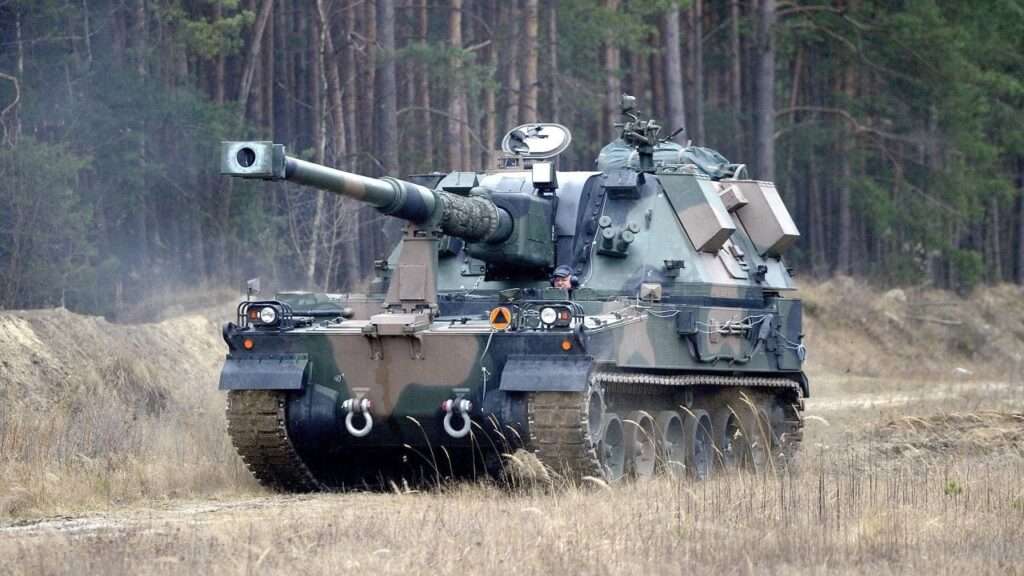
8. AHS Krab – Poland
Introduction & Development History
A combination of British AS-90M turret and South Korean K9 chassis, the Krab is Poland’s flagship self-propelled howitzer, tailored for NATO interoperability and rapid deployment.
Key Specifications
- Caliber: 155mm / L52
- Rate of Fire: 6–8 rpm sustained
- Max Range: 30–40 km (standard), 50 km (RAP)
- Ammunition Types: HE, smoke, BONUS anti-armor, precision-guided munitions
- Mobility: MTU 1,000 hp diesel engine, 60 km/h, ~400 km range
- Crew Size: 5
- Weight: ~52 tons
- Armor Protection: STANAG Level 2–3, NBC protection
- Unique Features: Hybrid NATO-standard platform, robust C2 systems
Fire Control & Targeting Systems
- Topaz integrated fire control system
- INS/GPS navigation, digital fire missions
- Compatibility with NATO-standard artillery networks
Operational Use & Combat History
- Used by Polish Army and supplied to Ukraine (2022–2024 war)
- Proved reliable in Eastern European combat environments
Strengths & Weaknesses
Strengths: High interoperability, combat-proven
Weaknesses: Heavier than some peers, higher operational cost
Variants
- Standard AHS Krab
- Future upgrades planned for automation and range extension

9. G6-52 Rhino – South Africa
Introduction & Development History
Developed by Denel Land Systems, the G6-52 is the evolution of the original G6, combining long-range artillery power with rugged, mine-resistant wheeled mobility, optimized for African and desert warfare.
Key Specifications
- Caliber: 155mm / L52
- Rate of Fire: 6 rpm sustained, burst fire of 3 rounds in 15 seconds
- Max Range: 30 km (standard), 54+ km (V-LAP)
- Ammunition Types: HE, cargo, smoke, illumination, precision V-LAP rounds
- Mobility: 6×6 wheeled, 85–90 km/h, ~700 km range
- Crew Size: 4–6
- Weight: ~46 tons
- Armor Protection: STANAG Level 2+, mine-resistant, NBC protection
- Unique Features: Exceptional operational range and off-road mobility
Fire Control & Targeting Systems
- Integrated fire control suite
- INS/GPS navigation
- Digital ballistic computation and command integration
Operational Use & Combat History
- Operated by South African National Defence Force and export clients
- Proven in African operational theatres under harsh conditions
Strengths & Weaknesses
Strengths: Long range, desert warfare mastery, high mobility
Weaknesses: Large profile, export challenges
Variants
- G6-52L: Extended range and improved fire control
- Export variants customized for client specifications
| Origin | United States | USA / United Kingdom | China | Brazil | Czech Republic | South Korea | Russia | Russia | South Korea | Turkey |
| Entered Service | 2005 | 1983 | 2004 | 1983 | 1972 | 2019 | 1988 | 1989 | 2015 | 2022 |
| Crew | 3 | 3–4 | 3 | 3 | 3 | 3 | 3 | 3 | 3 | 3 |
| Caliber | 227 mm / 610 mm (missile) | 227 mm | 300 mm | 127 mm – 300 mm | 122 mm | 239 mm | 220 mm | 300 mm | 239 mm / 600 mm | 107 mm – 600 mm |
| Max Range | 300 km (PrSM), 500+ km dev. | 70–300 km (GMLRS-ER) | 150 km | 12–300 km depending on rocket | 20–40 km | 80 km (standard), 290+ km dev. | 6–10 km (thermobaric) | 90 km (rockets), 120+ km dev. | 80–290 km | Up to 280 km |
| Warhead Types | HE, cluster, unitary, ATACMS | HE, cluster, unitary, guided | HE-frag, cluster, incendiary | HE-frag, cluster, incendiary | HE, fragmentation | HE, fragmentation, precision | Thermobaric, incendiary | HE-frag, cluster, fuel-air | HE-frag, precision, cluster | HE-frag, cluster, thermobaric |
| Number of Launch Tubes | 6 (rockets) / 1 (missile) | 12 rockets per pod (x2 pods) | 12 | Up to 16 | 40 | 8 (larger rockets) | 30 | 12 | Modular: up to 12 (rockets) | Modular: varies by caliber |
| Reload Time | ~10 min | ~15–20 min | ~20 min | Fast reload containerized | Moderate | ~15 min | ~24 min | ~20 min | ~15 min | Fast reload modular system |
| Guidance System | GPS/INS, laser for ATACMS | GPS/INS | GPS/INS optional | GPS/INS (on latest versions) | Unguided | GPS/INS | Unguided | GPS/INS (latest versions) | GPS/INS | GPS/INS, inertial, optional radar |
| Mobility | High mobility, 6×6 truck | Tracked armored chassis | 8×8 wheeled truck | 6×6 wheeled vehicle | 8×8 truck | Wheeled armored vehicle | Tracked armored chassis | 8×8 heavy truck | Wheeled armored chassis | Wheeled armored vehicle |
| Deployment Speed | Rapid | Moderate | Moderate | Rapid deployment | Moderate | Rapid | Moderate | Moderate | Rapid | Rapid |
| Combat Proven | Yes (Ukraine, Middle East) | Yes (Gulf War, Ukraine) | Limited export use | Yes (Middle East, Africa) | Limited regional conflicts | Yes (South Korea exercises) | Yes (Afghanistan, Chechnya) | Yes (Ukraine, Middle East) | Yes (South Korea) | Not yet, new system |
| Special Features | Fires both rockets and missiles incl. ATACMS/PrSM | Dual pod system, variety of munitions | Heavy firepower, long range | Highly modular, export success | Mass saturation capability | Precision and modular system | Devastating thermobaric warheads | Heavy saturation & cluster munitions | Modular with precision strike option | Wide range of calibers, modular |



Be the first to comment